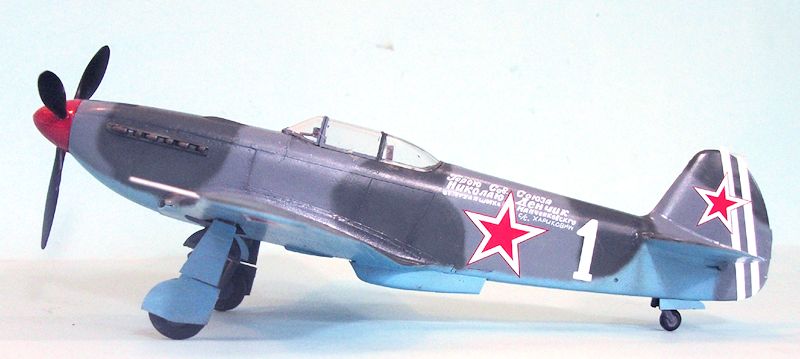
Zvezda 1/48 Yak-3
| IT #: | 4814 |
| PRICE: | US$21.00 @ HLJ (20% off MSRP) |
| DECALS: | Three options |
| REVIEWER: | Tom Cleaver |
| NOTES: | Aeromaster 48-642 “The Russians Are Here Part II” |

| HISTORY |
The Yakovlev Yak‑3 is
commonly considered the best sub-type of the wartime Yakovlev fighter series
that began with the Yak-1.
The Yak-3 was one of the smallest and lightest major
combat fighters fielded by any combatant; its high power‑to‑weight ratio gave it
excellent performance. Top-scoring French ace of World War II Marcel Albert, who
flew the type with the Normandie‑Niémen Group, considered it
aircraft to the P‑51D Mustang and the Supermarine
Spitfire in aerial combat.
The Yak-3s origins go
back to 1941, when the I‑30 was offered with the I‑26 as an alternative to the
Yak‑1. The I‑30 was powered by a Klimov M‑105P engine and construction was all
metal, with a wing incorporating dihedral on the outer panels. Armament was a 20
mm ShVAK cannon firing through the prop with
twin 7.62
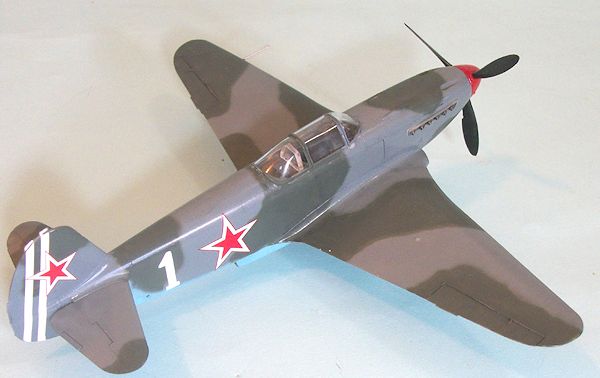 mm ShKAS
machine guns in the fuselage, and a ShVAK cannon in each wing. The first
prototype had a slatted wing to improve handling and short‑field performance
while the second had a wooden wing without slats, in order to simplify
production. While plans were made to put this Yak‑3 into production, the
scarcity of aviation aluminum combined with the need to produce a large number
of simple fighters quickly in the face of the Nazi invasion led to the first
Yak‑3 being abandoned in late 1941.
mm ShKAS
machine guns in the fuselage, and a ShVAK cannon in each wing. The first
prototype had a slatted wing to improve handling and short‑field performance
while the second had a wooden wing without slats, in order to simplify
production. While plans were made to put this Yak‑3 into production, the
scarcity of aviation aluminum combined with the need to produce a large number
of simple fighters quickly in the face of the Nazi invasion led to the first
Yak‑3 being abandoned in late 1941.
The Yak‑1M that
appeared in 1943 was a smaller and lighter version of the Yak‑1. One Yak‑1M
prototype was constructed later that year that incorporated plywood instead of
fabric covering the rear fuselage, a mastless radio antenna, reflector gunsight
and improved armor and engine cooling and a Klimov VK-107 engine. Chief test
pilot Petr Mikhailovich Stefanovskiy was so impressed he recommended the new
aircraft should completely replace the Yak‑1 and Yak‑7 with only the Yak‑9
remaining in production. The new fighter, designated quickly; by mid‑1946, 4,848
had come off the production lines.
The Yak-3 was
lighter and smaller than the Yak‑9, while powered by the same engine.
In service, it was found to be a forgiving,
easy‑to‑handle aircraft loved by both rookie and veteran pilots and ground crew
as well. It was robust and easy to maintain in primitive conditions.
The Yak-3
reached operational units during the summer of 1944, with service tests
conducted by 91st IAP of the 2nd Air Army in June‑July 1944.
In one large battle on June 16, 1944, 18 Yak‑3s fought
24 German aircraft, shooting down 15 for the loss of one Yak destroyed and one
damaged.
By the next day, Luftwaffe activity over that area of the front
virtually ceased. That day, eight Yaks attacked a formation of 60 German Ju-87s
and Bf-109Gs.
In the battle, the Germans lost 3 Ju-87s and four Bf-109Gs for no
Soviet 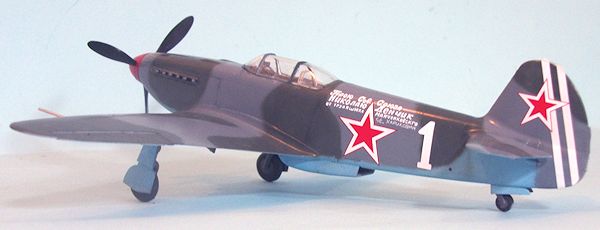 losses.
After this, the Luftwaffe issued an order to "avoid
combat with Yak fighters without an oil cooler under the nose below 5000
meters".
In late 1944, the Normandie‑Niemen Group re‑equipped with the Yak‑3,
scoring the last 99 of their 273 air victories with the aircraft, which they
later took with them to France where they were used for a short time in 1946.
losses.
After this, the Luftwaffe issued an order to "avoid
combat with Yak fighters without an oil cooler under the nose below 5000
meters".
In late 1944, the Normandie‑Niemen Group re‑equipped with the Yak‑3,
scoring the last 99 of their 273 air victories with the aircraft, which they
later took with them to France where they were used for a short time in 1946.
The Yak-3 was far from perfect. Wartime production quality problems included plywood surfaces coming unstuck when pulling out of a high‑speed dive, along with poor engine reliability and problems with the pneumatic system actuating landing gear, flaps and brakes, which was typical for all Yak fighters of the time.
| THE KIT |
This Yak-3 is
the third Soviet World War II fighter released by Zvezda in 1/48.
Like the La-5 and La-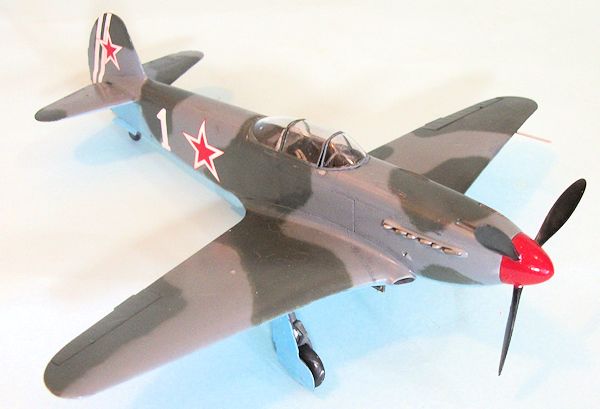 5FN
kits, it is the best representation of the real thing available in any scale,
with an overall fineness of design that represents the real airplane far better
than the now-elderly Eduard kit, the only other good kit of the Yak-3.
5FN
kits, it is the best representation of the real thing available in any scale,
with an overall fineness of design that represents the real airplane far better
than the now-elderly Eduard kit, the only other good kit of the Yak-3.
The kit provides
the option of assembly with the cowling off, providing a fully-detailed engine
and accessory and armament section within a well-designed airframe.
This is presented as a “power egg” to be attached to the
rest of the model after final assembly and painting.
Alternatively, the model can be assembled with the
cowling closed up, preserving the fine lines of the original.
The usual flat-finish Zvezda decals are provided for three aircraft, including “White 9" flown by top-scoring French ace Marcel Albert.
| CONSTRUCTION |
Overall, a
Zvezda kit is more of a well-designed limited-run kit with pretensions to a
mainstream injection kit.
One needs to watch for flash, and to test-fit parts
before committing glue.
That said, the model is well-designed, and everything
goes together very nicely if this care is taken.
I did not use any putty or surfacer on this model, other
than to run a line of CA glue down the centerline seam of the fuselage aft of
the cockpit.
The instructions are logical in their sequences and easy to
follow.
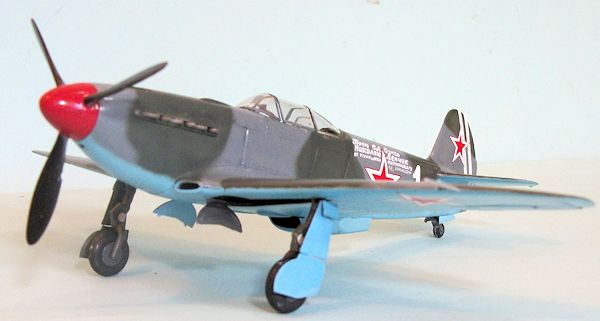
| COLORS & MARKINGS |
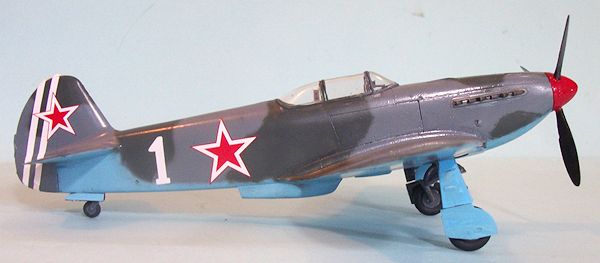
The kit decals
probably work, but I decided to use the decals for a Yak-3 flown by Major
Nikolai Fedorovich Denchik, Commander of the 4th
GIAD of the 1st Baltic Front in the
winter of 1944, as presented on Aeromaster’s sheet of Yak fighters, “The
Russians Are Here! Part II”.
These went down without problem, and I then applied a
coat of Xtracrylix Satin varnish overall.
| FINAL CONSTRUCTION |
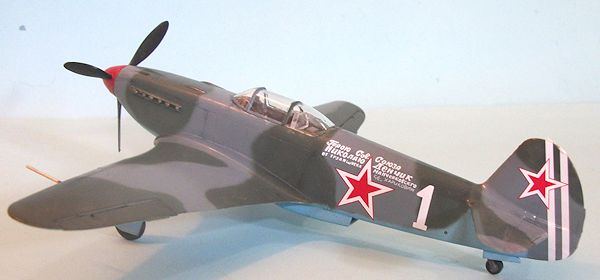
| CONCLUSIONS |
Review kit courtesy of HobbyLink Japan. Get yours at the link.
If you would like your product reviewed fairly and fairly quickly, please contact the editor or see other details in the Note to Contributors.